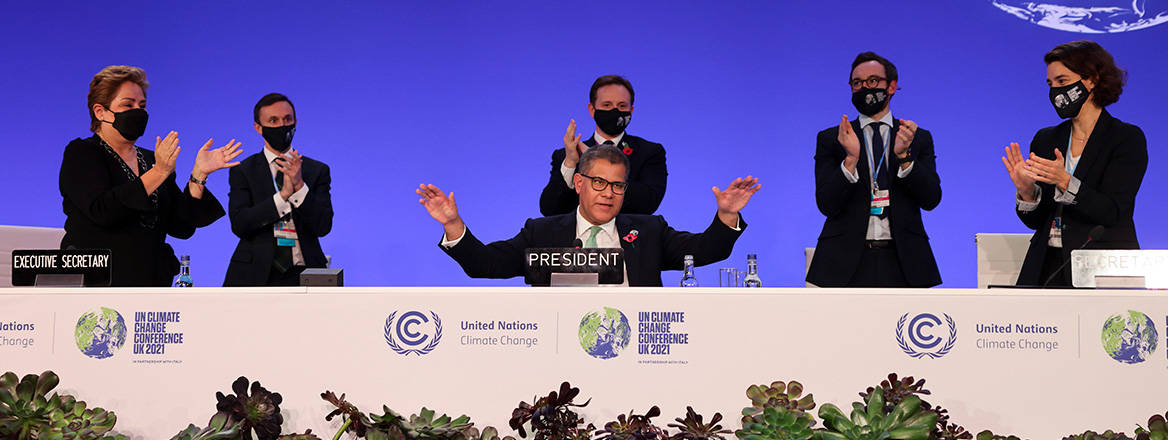Promises, Promises: What Did COP26 Actually Deliver?
Audiences are divided on whether COP26 represented a significant achievement or major disappointment in addressing the global climate crisis.
When the Paris Agreement was announced in 2015 the atmosphere was one of applause and optimism. In Glasgow, meanwhile, the mood was distinctly sombre, but no less emotional. Borrowing from the national security playbook, proceedings began with a warning from Boris Johnson that it was ‘one minute to midnight’ on the climate doomsday clock, and that ‘we must act now’.
In some ways, negotiating the Paris Agreement was easier. Although it united the world’s countries in a commitment to cut the greenhouse gas emissions causing global warming, much of the devil in the detail was left to COP26 negotiators. At Paris, a legally binding international treaty was signed pledging to limit global warming to 1.5 degrees; to achieve net zero – limiting greenhouse gas emissions to the same levels that trees, soil and oceans can naturally absorb – by 2050; to provide funding to poorer countries to help them adapt to climate change; and to review countries’ national climate plans every five years. These plans are known as nationally determined contributions (NDCs).
Owing to the one-year delay caused by the coronavirus pandemic, the first five-year review was undertaken at the COP26 summit in Glasgow. The Paris Rulebook dictates that climate action must become more ambitious over time. COP26, therefore, needed to follow up on the achievements at Paris, and in doing so ensure that countries improved plans to limit their emissions and that pledges to the climate mitigation fund reached the $100 billion per year goal.
After two weeks of negotiations, COP26 president Alok Sharma held back tears as he tapped the gavel to end proceedings, largely due to a last-minute ‘watering down’ of the ambition to ‘phase out’ coal and other fossil fuels. In a world where extreme weather is already a reality, climate activists and vulnerable countries quickly criticised the Glasgow Agreement for not going far enough. Others, however, feel the agreement represents a significant step towards keeping global temperature rises below 1.5 degrees.
What was Agreed at COP26?
Deforestation featured early on in the agenda, and by the end of the first day of negotiations, over 100 countries had signed up to the pledge to end deforestation by 2030. Some 141 countries signed up to the Glasgow Leaders’ Declaration on Forests and Land Use, recognising the vital role trees play in carbon sequestration. As much as 40% of the existing Amazon rainforest is at risk of becoming savannah, according to a study published in the journal Nature Communications last year.
Transport was also central to discussions. While notable big players did not pledge their support, 24 countries and many leading car manufacturers agreed to phase out fossil fuel-powered vehicles by 2040. Backed by investors and banks, who said they would support the transition, this agreement recognised the need to address the transport sector’s contribution to carbon emissions. In the EU, road transportation accounts for 70% of the overall emissions from the transport sector.
Current predictions suggest the Glasgow commitments, if realised, would still result in a 2.4 degree global temperature rise, leading to catastrophic impacts in all countries
A commitment to create green shipping corridors also saw 22 countries promise to create at least six zero-emission maritime routes by 2025.
Climate finance was also central to negotiations, and the Glasgow Agreement saw many of the world’s richest countries pledge to increase their contributions. Climate finance is intended to assist developing countries to prevent or adapt to the ‘loss and damage’ resulting from climate change, equipping them with loans and grants to invest in new infrastructure and technology. Estimates suggest that pledges from COP26 will amount to $93 billion a year by the end of 2022.
Fossil fuel use featured prominently in discussions, and the close of COP26 saw a commitment to limit global coal use. This marked the first time a resolution targeting fossil fuel use has been included in the UN Climate Process – an undoubtedly momentous achievement. Coal is the single biggest contributor to climate change and is responsible for over 40% of annual carbon emissions. Despite the last-minute revision to the resolution – where language was ‘watered down’ from promising to ‘phase out’ coal use to instead ‘phase down’, triggering the emotional response from Alok Sharma – the agreement signalled a strong international push to move away from fossil fuels.
Do the Commitments Go Far Enough?
In short, no. Current scientific predictions suggest the Glasgow commitments, if realised, would still result in a 2.4 degree global temperature rise, leading to catastrophic impacts in all countries. In 2009, vulnerable countries were promised $100 billion per year in climate mitigation finance by 2020. Pledges remain nowhere near this level.
Sadly, the practices and industries that contribute most to climate change are currently at the centre of our global economy. Thus, the two-week long negotiations in Glasgow were never predicted to result in a done deal to solve the climate crisis, despite the proverbial ticking doomsday clock.
Despite mounting pressure to include military emissions in proceedings, they were not a feature of the formal agenda in Glasgow. Under the Paris Agreement, all military-related reporting is voluntary. Owing to its fuel usage alone, the US military contributes more to climate change than many of the industrialised countries gathered at COP26.
However, despite falling short, the targets agreed in Glasgow are – if realised – progress towards the ultimate goal. Most countries improved their pledges on previous years, although several were light on detail.
The next 12 months will ultimately begin to test whether the pledges, promises and commitments at COP26 will translate into tangible action
The last-minute ‘watering down’ of the language in the Glasgow Agreement caused many to view negotiations as having failed at the final hurdle. Coupled with the civil society view that achievements had been overhyped by the UK government in order to mask inherent shortfalls and loopholes, the disillusionment felt by many at the close of COP26 was not entirely unexpected.
The conference was not the turning point needed to reach the 1.5 goal. What did COP26 ultimately deliver? More promises and pledges.
Is There Hope in the Year Ahead?
In Glasgow, the richest countries – those profiting most from fossil fuel use – again came face-to-face with those most impacted by the climate crisis. Aminath Shauna, environment minister of the Maldives, stated that the new deal did not ‘bring hope’ and that ‘the difference between 1.5C and 2C is a death sentence for us’. Clearly, time is running out for those most vulnerable to climate change. 1.5 degrees is still attainable, but the window is closing fast.
The next 12 months will ultimately begin to test whether the pledges, promises and commitments at COP26 will translate into tangible action. Countries will need to bolster their international promises with strong legislation and action at home, and further improve their NDCs.
Perhaps we can find a small amount of hope in the fact that the promises at COP26 were moderate. A more forceful agreement at Glasgow may have simply presented an array of empty promises and targets on which countries would inevitably underdeliver. After all, COPs have historically underdelivered.
With individual countries being encouraged to improve their NDCs for next year’s COP27 in Sharm El-Sheikh, the world waits with bated breath for our governments to enact what was promised and again improve their pledges.
The views expressed in this Commentary are the author’s, and do not represent those of RUSI or any other institution.
Have an idea for a Commentary you’d like to write for us? Send a short pitch to commentaries@rusi.org and we’ll get back to you if it fits into our research interests. Full guidelines for contributors can be found here.
WRITTEN BY
Lauren Young
Former Research Fellow


